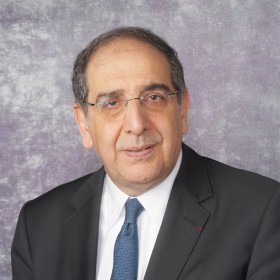
3:00 pm to 4:30 pm
GHC 6115
José Alain Sahel, MD
Professor & Chairman, Department of Ophthalmology, University of Pittsburgh, School of Medicine
Abstract
Progress in ophthalmology over the past decade moved preclinical data to clinical proof-of-concept studies bringing innovative therapeutic strategies to the market. Diseases such as retinitis pigmentosa (RP) and age-related macular degeneration (AMD) destroy photoreceptors but leave intact and functional a significant number of inner retinal cells. Retinal prostheses have demonstrated ability to reactivate the remaining retinal circuits at the level of bipolar or ganglion cells, after the photoreceptor loss. Recent clinical trials have demonstrated partial restoration of vision in blind people by epiretinal (Second Sight Medical Products, Pixium Vision) and subretinal (Retina Implant AG) implants, in clinical trials and practice now. Despite a limited number of electrodes, some patients were even able to read words and recognize high-contrast objects. Currently, researchers at the Stanford University and Pixium Vision in collaboration with Institut de la Vision develop a wirelessly powered photovoltaic prosthesis in which each pixel of the subretinal array directly converts patterned pulsed near-infrared light projected from video goggles into local electric current to stimulate the nearby retinal neurons. A new asynchronous dynamic visual sensor whose function mimics photoreceptor and retinal cell responses is also under development. Optogenetics (currently under preclinical evaluation in primates) and cell therapy (ongoing first safety and tolerability clinical trials with hESC- and iPSCs-derived RPE) provide alternative approaches for vision restoration in patients with advanced stages of retinal degeneration. Combination of different therapeutic strategies may offer enhanced therapeutic effectiveness and more efficient ways to save vision. These new therapeutic tools call for identification of appropriate patient selection criteria and methods to evaluate treatments’ efficiency and assess the real benefit experienced by the patients.
Additional Information
Host: Martial Hebert
Appointments: Stephanie Matvey (smatvey@cs.cmu.edu)
Speaker Biography
José-Alain Sahel studied medicine at the Medical School of Paris University and ophthalmology at the University of Strasbourg and at Harvard University (Boston-Cambridge, USA). He was appointed Professor of Ophthalmology at the University Louis Pasteur, Strasbourg. Currently, José-Alain Sahel is Professor of Ophthalmology at Pierre and Marie Curie University Medical School, Paris, France and Cumberlege Professor of Biomedical Sciences at the Institute of Ophthalmology-University College London, UK. He chairs the Departments of Ophthalmology at the Quinze-Vingts National Eye Hospital and at the Rothschild Ophthalmology Foundation. He was recently appointed Professor and Chairman of the Department of Ophthalmology at the University of Pittsburgh Medical School and The Eye and Ear Foundation Endowed Chair. The primary focus of Sahel’s fundamental and clinical research is the understanding of the mechanisms associated with retinal degeneration, together with the conception, development and evaluation of innovative treatments for retinal diseases, with a special focus on genetic rod-cone dystrophies (e.g. neuroprotection, stem cells, gene therapy, pharmacology, and artificial retina). The group of José-Alain Sahel (with Saddek Mohand-Said and Thierry Léveillard) was the first to hypothesize and demonstrate that rod photoreceptors produce a protein that rescues cone photoreceptors, thereby maintaining light-adapted and high-resolution vision. This molecule, Rod-derived Cone Viability Factor (RdCVF), is now in translation into a possible therapeutic agent to save cones and treat a spectrum of retinal degenerative diseases. Once rods and cones have degenerated, optogenetics -a promising novel therapeutic strategy- provides alternative to restore vision. Sahel‘s group (with Serge Picaud and Botond Roska at the Friedrich Miescher Institute for Biomedical Research) demonstrated that different retinal cell types such as “dormant cones” can be converted into “artificial photoreceptors” by targeting the expression of genetically encoded light sensors enabling mice with retinal degeneration to perform visually guided behaviors. Besides research on developmental biology, functional genomics, physiology and therapeutics, Sahel’s laboratory (with Michel Paques, Saddek Mohand-Said and Isabelle Audo) conducts research on genotype-phenotype correlations with high resolution in vivo non-invasive high-resolution retinal imaging techniques (optical coherence tomography and adaptive optics) aiming at identifying patients eligible for clinical application of innovative therapies. Together with Mathis Fink (Institut Langevin) he is the principal investigator of a very large ERC-synergy grant (HELMHOLTZ) aiming at developing novel technologies for morpho-functional imaging of the visual system. José-Alain Sahel is founder and director of the Institut de la Vision in Paris, a site for translational research on treatments for currently untreatable inherited and age-related ocular diseases that comprises 18 principal investigators and more than 250 staff members, and functions in synergy with the Quinze-Vingts National Eye Hospital. He coordinates the Paris-based Ophthalmology Clinical Investigation Center, overseeing more than 50 clinical trials, some of them within the most advanced areas of biomedical technologies worldwide, such as retinal implants and gene therapy. José-Alain Sahel heads the National Reference Center for Retinal Dystrophies and chairs a network of more than 90 European clinical trial centers on retinal diseases. He published over 350 peer-reviewed articles and co-authored more than 20 patents. He was a founder of Fovea pharmaceuticals, which became the ophthalmological division of Sanofi, and is a scientific co-founder of GenSight Biologics and Pixium Vision.
February 10, 2017, 3:00-4:30, GHC 6115
